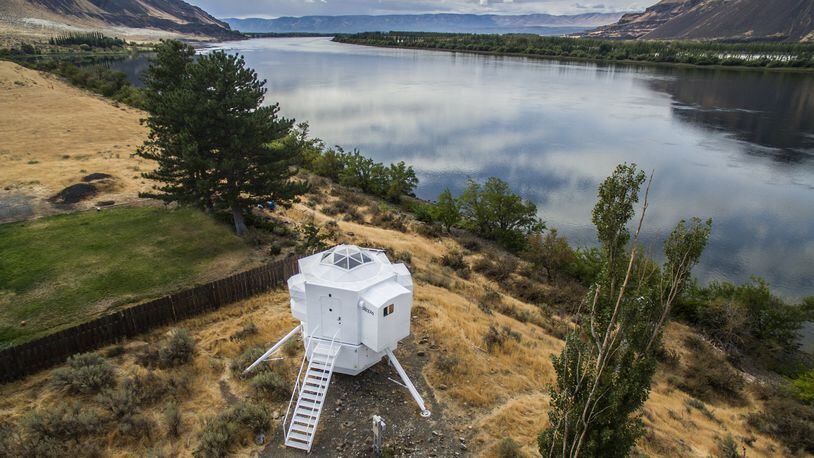Hughes launched this inspired mission about 10 years ago: His youngest daughter, Kiku, attended space camp at The Museum of Flight, so Hughes printed her a lunar-module graphic, and then actual Apollo 13 astronaut Fred Haise signed it. (The graphic, now framed, hangs in a spot of honor just inside the lander’s portal.)
“I never have seen anyone living in a lunar lander,” Hughes says. “They’re mostly uninhabitable. But Haise said to my daughter: ‘The one we took was pretty comfortable.’ ”
Hughes is a naval architect whose Seattle-based company, Kurt Hughes Sailing Designs, caters to comfortable. “If you go to Maui, about half the tour-boat catamarans are my designs,” he says.
With the lunar lander, though, Hughes saw a space challenge, and more than one opportunity.
“Typically, an architect can look at a building and understand what’s going on,” he says. “I looked at the lunar lander and couldn’t figure it out. While it always was, ‘Don’t just do a box, like almost everybody else,’ this is a proof of concept for building a house like a modern boat is built.”
As a bonus, Hughes’ lunar lander (and its pad of riverfront land, near Beverly) honors his past (he went to Royal High School, “20 miles up the road”), and the space program’s. “I wanted an homage to an era when anything was possible,” he says. “And, the Apollo astronauts trained only a few miles from here.”
Practically, Hughes says, the lunar lander “will be a weekend getaway place, especially for creative work, and for the kids to visit the Gorge events.” (He lives full-time in Seattle with his wife, Eugenia; they have two grown daughters: Mariko and Kiku the space-camper.)
Structurally, Hughes envisioned “a habitable dwelling with the latest marine composite technology, providing creature comforts with low impact on the land and high amazement factor.”
Modestly, he calls it “an unusual project.” We’ll just say: We are highly amazed, and unusually impressed.
This is no tiny house that vaguely resembles something space-y, fellow Earthlings. This is a “retrofuturist” and officially permitted lunar-lander tiny house (total weight, less than 3,000 pounds; total square footage, 250). It kind of stands out.
“There are four sides and four truncations — it’s technically a hexagon,” Hughes says. “The intent is that it’s cool from every side.”
Six stretchy cables act as tethers; three spidery steel legs attach to reinforced concrete pads; and a fourth stabilizer holds the 12 solar-lighted steps that lead to the front door, which, naturally, has a porthole. On the other side, under a sun-shading array of photovoltaic panels: a deck for two, perfect for watching the Columbia roll on.
Inside, on the main level (an airy, open space with “external modules for the bath, galley, breakfast nook and storage”), a clear, geodesic dome overhead lets “light stream in, down, all around,” Hughes says. Down the interior ship’s ladder: “a soft lounging pit and bed” (and required fire egress). All systems go away, tucked in the hexagonal ring under the living space.
The work (and ingenuity) behind all of that is staggering:
— Eliminating “the need for old-style nail framing,” Hughes built his own structural insulated panels (SIPs). “I am expert in building (them) easily: much higher strength and quality than commercial ones,” he says. “I pioneered using Ziploc Space Bags for vacuum-bagging smaller SIPs. A shop vac, bubble pak and Poly Tarp are all that is needed.”
— Epoxy coats every part, he says: “Epoxy keeps everything dry, and mold cannot get a foothold.” (He even created a phosphorescent epoxy floor for the bathroom — so aglow, it “rarely needs nightlights.”)
— Hughes used a rubberized nonskid paint, Evercoat, on the ship’s ladder treads. “Out of the can, it looks like pale alien hurl,” he says. “I added graphite powder to the mix to give a dark-gray, OSHA-looking result.”
— While saving space (the toilet tank is only 3 inches wide, front to back), Hughes also prioritized energy savings, with a quarter-ton ductless heat pump, air-to-air heat exchanger, and “state-of-the-art marine 12-volt electrical systems and LED” lighting.
There were a few delayed liftoffs: Fitting the door handles took “a crazy amount of time,” he says. It didn’t occur to him originally that he’d need an attached exterior ladder so he actually could work up high — but there’s one now. And with the shower door, “The goal with composite construction is to drill as few holes as possible,” he says. “I tried to hang it with only high-strength 3M VHB tape so I could escape drilling into the plywood. It failed. Now I know: I must drill.”
There’s a universal lesson there, he says: “It’s real important to build the stuff you’re designing. I design boats for others, and build for myself. Too many builders don’t get their hands dirty.”
Hughes has taken giant steps for do-it-yourselfers-kind, but his lunar lander remains an active exploration.
“At some point, I’ll be done enough,” he says. “When I’m 85 and sitting in that captain’s window and sipping absinthe.”
About the Author
